FY2015 Annual Report
Light-Matter Interactions Unit
Associate Professor Síle Nic Chormaic
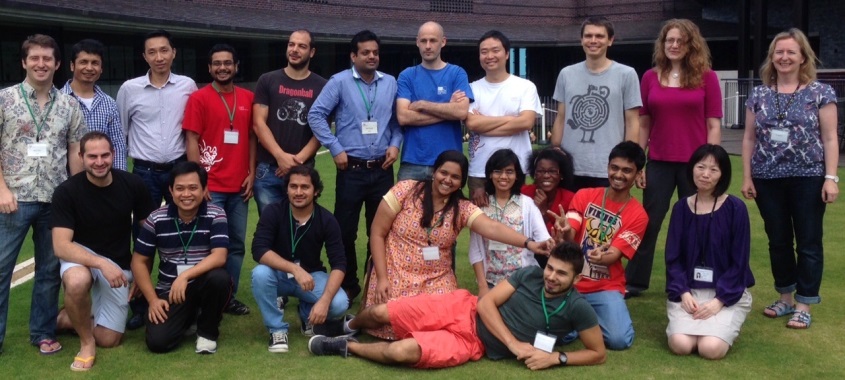
Abstract
This year the group focussed on work related to nanofibre-mediated nonlinear optics in cold atomic systems, particle trapping at the nanoscale and sensing using whispering gallery resonators. Amongst the major outputs were a proposal for atom trapping based on a nanostructured optical microfibre, the first demonstration of the interaction of higher order optical fibre modes with cold atoms, a demonstration of the Autler-Townes effect in an atomic system for ultralow powers, a model and demonstratioin of optical binding for micron sized particles next to optical nanofibres and the demonstration of nonlinear effects in a variety of whispering gallery resonators.
1. Staff
Research Staff
- Dr. Viet Giang Truong, Group Leader/Staff Scientist
- Dr. Jonathan Ward, Staff Scientist
- Dr. Yong Yang, Postdoctoral Scholar
- Dr. Tridib Ray, Postdoctoral Scholar
- Dr. Jinjin Du, Postdoctoral Scholar (from July 2015)
- Dr. Xue Han, Postdoctoral Scholar (from August 2015)
- Dr. Vandna Gokhroo, Postdoctoral Scholar (until September 2015)
- Dr. Ivan Gusachenko, Postdoctoral Scholar (until November 2015)
- Dr. Marios Sergides, Postdoctoral Scholar (until November 2015)
Support Staff
- Ms. Emi Nakamura, Research Administrator
- Mr. Le Hong Vu, Technician (until September 2015)
- Mr. Vikraman Karunanidhi, Technician (from July 2015 to February 2016)
- Mr. Metin Ozer, Technician (from December 2015)
- Dr. Kristoffer Karlsson, Technician (from January 2016)
- Dr. Aysen Gurkan Ozer, Part-time technician (from January 2016)
PhD Students
- Mr. Mark Daly, OIST PhD student
- Mr. Thomas Nieddu, OIST PhD student
- Mr. Simon Peter Mekhail, OIST PhD student
- Ms. Krishnapriya Subramonian Rajasree, OIST PhD student (from September 2015)
- Mr. Sho Kasumie, OIST PhD student (from January 2016)
- Mr. Ravi Kumar, UCC PhD/OIST special research student (until January 2016)
- Mr. Ramgopal Madugani, UCC PhD/OIST special research student
- Mr. Aili Maimaiti, UCC PhD/OIST special research student
Rotation/Intern Students
- Ms. Christina Lee, OIST PhD Rotation Student (January-April 2015)
- Ms. Ruth Thompson, OIST PhD Rotation Student (May-August 2015)
- Ms. Krishnapriya Subramonian Rajasree, OIST PhD Rotation Student (May-August 2015)
- Ms. Cindy Esporlas, OIST PhD Rotation Student (September-December 2015)
- Ms. Sahar Hejazy, OIST PhD Rotation Student (September-December 2015)
- Mr. Sho Kasumie, OIST PhD Rotation Student (September-December 2015)
- Mr. Pranam Prakash, Research Intern, CUSAT, India (January-May 2015)
- Mr. Yuta Ooka, Research Intern, Keio University, Japan (February-April 2015)
- Mr. Tushar Kanti Saha, Research Intern, IISER-Kolkata, India (May-July 2015)
- Mr. Colum O'Leary, Research Intern, TCD, Ireland (June-September 2015)
- Ms. Christiane Ebongue, Research Intern, University of Maryland, USA (April-September 2015)
- Mr. Sanele Dlamini, Research Intern, PhD student UKZN, South Africa (July-December 2015)
- Mr. Pei Zeng, Research Intern, Nanjing University, China (October-December 2015)
- Ms. Wenfang Li, Research Intern, PhD student Shanxi University, China (December 2015-May 2016)
UCC: University College Cork, Ireland
2. Collaborations
- Theme: Quantum control
- Type of collaboration: Joint research
- Researchers:
- M. Nakahara (Kindai University, Osaka, Japan)
- Theme: Nonlinear materials for WGM resonators and packaged WGM devices
- Type of collaboration: Joint research
- Researchers:
- P. Wang and G. Farrell (Dublin Institute of Technology, Ireland)
- X. Feng and G. Brambilla (ORC, University of Southampton, UK)
- P. Wang and H. Zhao (Harbin Engineering University, China)
- Theme: Particle trapping using WGM resonators
- Type of collaboration: Joint research
- Researchers:
- Y.-F. Xiao (Peking University, China)
- Y.-F. Xiao (Peking University, China)
- Theme: Using lensed fibres for ex-vivo retina stimulation (single photon studies)
- Type of collaboration: Joint research
- Researchers:
- A. Tavala and A. Zeilinger (Universität Wien, Austria)
- A. Tavala and A. Zeilinger (Universität Wien, Austria)
- Theme: SFI Ireland-Japan International Strategic Cooperation Award
- Type of collaboration: Joint research
- Researchers:
- P. Wang and G. Farrell (DIT, Ireland)
- A. Ruschhaupt and A. Ruth (UCC, Ireland)
- M. Bardosova and M. Pemble (UCC-Tyndall, Ireland)
- Theme: Plasmonic structures on optical nanofibres for atom trapping
- Type of collaboration: Joint research
- Researchers:
- F. Petruccione, M. Tame and S. Dlamini (University of Kwazulu-Natal, South Africa)
- H. Mulder (FEI Electron Optics, Netherlands)
- Theme: Deep Brain Imaging by Means of Fibre Micro-endoscopy
- Type of collaboration: Joint research
- Researchers:
- O. Jáidar and G. Arbuthnott (Brain Mechanisms for Behaviour Unit, OIST)
3. Activities and Findings
3.1 NanoBioOptics Group
Nanoparticle trapping by an ultrathin optical fibre
We present an evanescent field-based device which can confine low refractive index contrast nanoscale particles using modest optical powers (< 1.2 mW) with additional applications in the field of cold atom trapping. We currently focus on using a nanostructured ultrathin optical fibre to trap 100 and 200 nm, low index contrast, fluorescent particles within the structured region, thereby overcoming diffraction limitations. We hope to analyse the trapping potential of this device both experimentally and theoretically, and determine the trap characteristics through analysis of the transmitted laser beam. We have demonstrated the fabrication of such devices with high resolution, as well as some early results showing the trapping of 100 nm polystyrene particles.
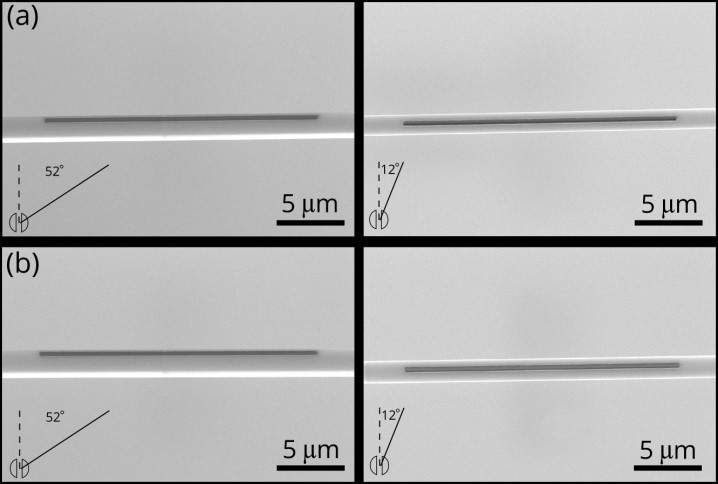
Figure 1. SEM images of nanostructured ultrathin optical fibres. Waist diameter 1.4 µm. Slot width 300 nm. Slot length 20 µm.

Figure 2. Still images taken from a video showing the trapping of 200 nm particles using a total power of 30 mW.
Higher order mode propulsion
We demonstrated propulsion of particles in the evanescent field of fundamental and first group of higher order modes. Using a microfiber/optical tweezers compact system, specific number of particles are trapped and propelled in the evanescent field of an ultrathin fibre. The dependence of the particles’ speeds on their diameter is studied for 1 μm, 3 μm, and 5 μm diameter polystyrene particles using the higher order modes of the fibres. The optical propelling velocity of a single, 3 μm polystyrene particle was found to be 8 times faster under the higher order mode than the fundamental mode field for a waist power of 25 mW. These results highlight the special properties of higher order modes, such as their larger evanescent field amplitudes and longer evanescent field extensions from the fibre’s surface, when compared to what can be achieved for FM propagation. Experimental data are supported by theoretical calculations. This work can be extended to trapping and manipulation of laser-cooled atoms with potential for quantum networks.
Nanoparticle trapping with a tunable plasmonic device
In this work, we demonstrated a tunable plasmonic nanodevice which can improve both the trapping field enhancement and detection of nano-objects using singular phase drops in the NIR range. The plasmonic nanodevice consists of an array of nanoring structures connected by slots 50 nm x 50 nm dimensions. These slots act as individual detection and trapping sites. The tunability of the system is achieved by increasing the inner disk size inside of nano-holes. We report experimental evidence of 100 nm polystyrene beads trapping using low incident power on these devices.
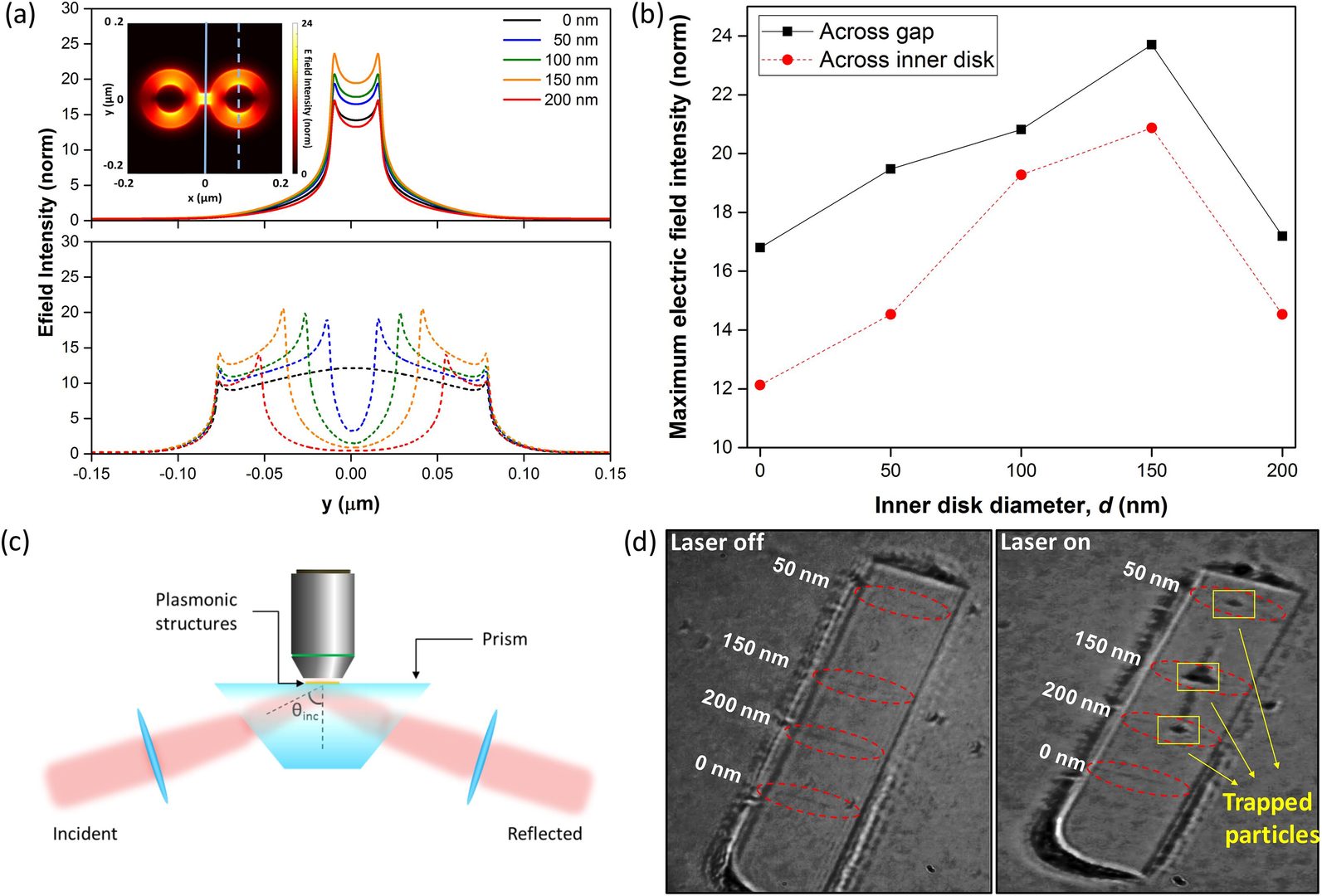
Figure 3. Electric field distribution perpendicular to (a) the trapping gap (solid) and to the left inner disk (dashed). (b) Maximum electric field intensity values taken from (a). The inset shows the axis along which the calculations were made. (c) Schematic of the Kretschmann configuration used to experimentally excite the devices. (d) Device fabricated with different inner disk sizes, d, as viewed under a 20X microscope objective (left). Laser source tuned at λ= 950 nm and incident angle θinc = 63°. Polystyrene particles with diameter 100 nm are quickly confined in the arrays with the 150 nm array accumulating a larger number of particles.
3.2 Optical Cavities and Sensing Group
In 2015 the Whispering Gallery Resonator Group within the Light-Matter Interactions Unit have continued to work with microcavities for sensing, optomechanics and nonlinear optics.
The tunability of an optical cavity is an essential requirement for many areas of research. We used the Pound–Drever–Hall technique to lock a laser to a whispering gallery mode (WGM) of a microbubble resonator, to show that linear tuning of the WGM, and the corresponding locked laser, display almost zero hysteresis, see Fig. 1. By applying aerostatic pressure to the interior surface of the microbubble resonator, optical mode shift rates of around 58 GHz/MPa are achieved. The system can measure pressure with a detection limit of 2 × 10−4 MPa, which is an improvement made on pressure sensing using this device. The long-term frequency stability of this tuning method for different input pressures is measured. The frequency noise of the WGM measured over 10 min for an input pressure of 0.5 MPa had a maximum standard deviation of 36 MHz.

Fig. 1(left): Laser frequency shift as a function of applied pressure. Solid red (blue) curve represents the laser frequency change for applied pressure in increasing (decreasing) direction. (Right): Long term stability, frequency as a function of time.
Coupled-mode-induced transparency was realized in a single microbubble whispering-gallery mode resonator. Using aerostatic tuning, we find that the pressure-induced shifting rates are different for different radial order modes, see Fig. 2. A finite element simulation considering both the strain and stress effects shows a GHz/bar difference, and this was confirmed by experiments. A transparency spectrum was obtained through precise pressure tuning. The resulting line shapes were fitted with theory. This work lays a foundation for future applications in microbubble sensing.
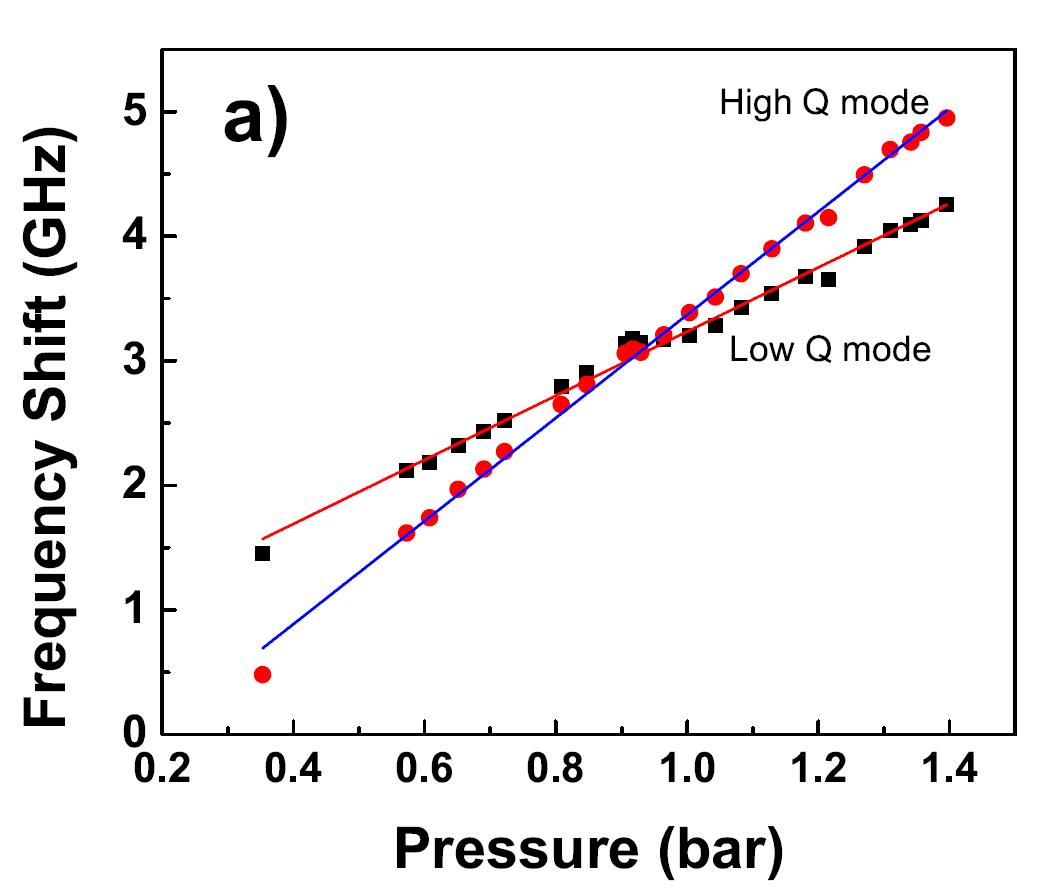
Fig. 2. Pressure tuning rate of a high Q mode (red dot) and a low Q mode (black square).
Dissipative optomechanics has some advantages in cooling compared to the conventional dispersion dominated systems. We studied the optical response of a cantilever-like, silica, microsphere pendulum, evanescently coupled to a fiber taper. In a whispering gallery mode resonator, the cavity mode and motion of the pendulum result in both dispersive and dissipative optomechanical interactions. This unique mechanism leads to an experimentally observable, asymmetric response function of the transduction spectrum, which can be explained using coupled-mode theory, see Fig. 3.

Fig. 3. (Left): Schematic of a taper-coupled micropendulum system. Inset: image of the micropendulum; (b) Fourier transform spectrum of the transmitted signal through the fiber taper as the pendulum moves relative to the fiber. (c) dissipative and (d) dispersive modulation. (e) A typical transduction response to cavity detuning for the 1 kHz mechanical mode peak. (Right): Coupled mode theory with experimental results, red squares (dotted blue) are the experimental data for the peak amplitudes of the maximum transduction for red(blue) detuning of the optical mode. Red(Blue) curve was obtained from coupled mode theory.
The fabrication of an ultrahigh-quality-factor, bottle-like microresonator from a microcapillary and the realisation of Raman lasing therein at pump wavelengths of 1.55 µm and 780 nm was achieved in 2015. The dependence of the Raman laser threshold on the mode volume was investigated. The mode volume of the fundamental bottle mode was calculated and compared with that of a microsphere. Third-order cascaded Raman lasing was observed under pumping at 780 nm, see Fig. 4. A hollow, bottle-like microresonator (BLMR) was fabricated from a microcapillary with a nearly parabolic profile. From simulations at 1.55 μm the fundamental bottle mode is shown to be in the anomalous dispersion regime, while the conventional whispering gallery mode, confined to the center of the BLMR, is in the normal dispersion regime. We have experimentally shown that, for a BLMR with a diameter of 102 µm, degenerate four-wave mixing can only be observed by judicious selection of the tapered fiber coupling position.

Fig. 4. (Left): Raman spectrum when the pump power is above the threshold. The wavelength of the pump laser and Raman scattering are 1545.1 and 1654.5 nm, respectively. Inset: relationship between the power of the pump and Raman scattering. The black line is a linear fit to the data. (Right) Four wave mixing in BLMR.
Sensors based on whispering gallery resonators have minute footprints and can push achievable sensitivities and resolutions to their limits. Here, we use a microbubble resonator, with a wall thickness of 500 nm and an intrinsic Q-factor of 107 in the telecommunications C-band, to investigate aerostatic pressure sensing via stress and strain of the material. The microbubble is made using two counter-propagating CO2 laser beams focused onto a microcapillary. The measured sensitivity is 19 GHz/bar at 1.55 μm. We show that this can be further improved to 38 GHz/bar when tested at the 780 nm wavelength range. In this case, the resolution for pressure sensing can reach 0.17 mbar with a Q-factor higher than 5 × 10^7, see Fig. 5.
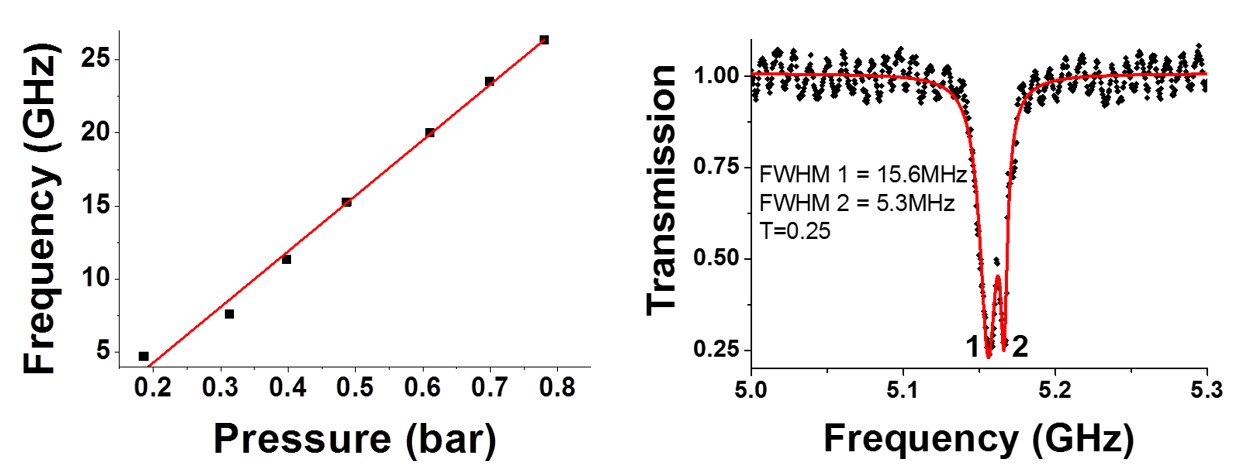
Fig. 5. (Left): Pressure tuning of ultra-thin high-Q microbubble. (Right): WGM at 780 nm in an ultra-thin microbubble with Q in excess of 10^8.
Flow sensing using the concept of a hot whispering gallery microlaser was also demonstrated in 2016. Silica microcapillaries or microbubbles, coated with a layer of erbium:ytterbium (Er:Yb) doped phosphate laser glass, result in a hollow, microbottle-shaped laser geometry. The Er:Yb doped glass outer layer was pumped at 980 nm via a tapered optical fiber and whispering gallery mode lasing was recorded at 1535 nm. When gas passes through the capillary, the WGMs shift toward shorter wavelengths due to the cooling effect of the fluid flow. In this way, thermal tuning of the lasing modes over 70 GHz can be achieved. Gas flow rates were calibrated against a commercial mass flow sensor, see Fig. 6.

Fig. 6. (Left): Lasing spectrum from an Er:Yb doped bottle-shaped resonator on a silica capillary. Inset: Image of the resonator showing a WGM which is visible due to the green upconversion fluorescence (Right): Shift of the 1535 nm lasing WGM as a function of the measured flow rate for different pump powers. The solid lines are fits to the experimental data.
3.3 Neutral Atoms for Quantum Technologies Group
Non-linear optics in laser-cooled 87Rb at ultra-low powers using an optical nanofiber
Ultrathin optical fibres integrated into cold atom setups are proving to be ideal building blocks for atom-photon hybrid quantum networks. Such optical nanofibres (ONFs) can be used for the demonstration of nonlinear optics and quantum interference phenomena in atomic media. We observed multilevel cascaded electromagnetically induced transparency (EIT) using an optical nanofibre embedded into a cloud of cold 87Rb atoms. Intense evanescent fields at the ONF allows us observe the effect with ultralow pump powers. The corresponding Rabi frequencies and EIT linewidths are calculated. Finally, the phenomenon is used to demonstrate an all optical switch.
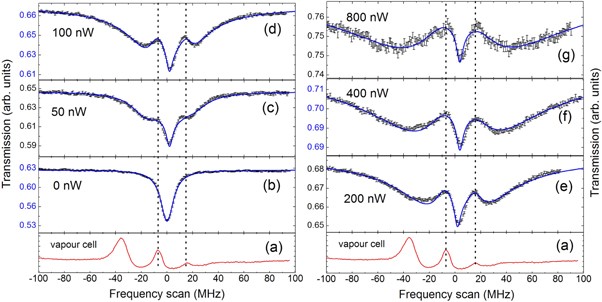
Figure 1: Multiple EIT peaks for coupling beam powers from 0–800 nW as indicated on the graphs. The probe power is 5 pW. The reference signal obtained in a vapour cell (red curves) is used for frequency calibration.

Figure 2: All optical switch demonstrated using the ONF based EIT. Black: photon counts obtained with 10 kHz on–off modulation of the coupling beam in the presence of cold atoms with background counts subtracted. Red: electrical reference signal used for switching on and off the coupling beam. The data is averaged for 150 runs.
We also used an optical nanofibre embedded in a cloud of laser-cooled Rb-87 for near-infrared frequency up-conversion via a resonant two-photon process. Sub-nW powers of the two-photon radiation, at 780 and 776 nm, copropagate through the optical nanofiber and the generation of 420 nm photons is observed. A measurement of the Autler-Townes splitting provides a direct measurement of the Rabi frequency of the 780 nm transition. Through this method, dephasings of the system can be studied. In this work, the optical nanofibre was used as an excitation and detection tool simultaneously, and it highlights some of the advantages of using fully fibred systems for nonlinear optics with atoms.
4. Publications
4.1 Journals
- Daly, M., Sergides, M. & Nic Chormaic, S. Optical trapping and manipulation of micrometer and submicrometer particles. Laser & Photonics Reviews 9, 309-329, doi:10.1002/lpor201500006 (2015).
- Daly, M., Troung, V. G. & Nic Chormaic, S. Nanostructured tapered optical fibers for paticle trapping. SPIE Proceedings, Micro-structured and Specialty Optical Fibres IV 9507, 95070E, doi:10.1117/12.2182340 (2015).
- Daly, M., Truong, V. G. & Nic Chormaic, S. Submicron particle manipulation using slotted tapered optical fibers. SPIE Proceedings, Optical Trapping and Optical Micromanipulation XII 9548, 954812, doi:10.1117/12.2189168 (2015).
- Gokhroo, V., Kumar, R. & Nic Chormaic, S. Optical nanofiber facilitated nonlinear optics effects in cold atoms SPIE Proceedings, Nonlinear Optics and Applications IX 9503, 95030D, doi:10.1117/12.2182341 (2015).
- Gusachenko, I., Truong, V. G., Frawley, M. & Nic Chormaic, S. Optical nanofiber integrated into optical tweezers for in-situ fiber probing and optical binding studies. Photonics 2015 795-807, doi:10.3390/photonics2030795 (2015).
- Kumar, R., Gokhroo, V., Deasy, K. & Nic Chormaic, S. Autler-Townes splitting via frequency upconversion at ultra-low power levels in cold 87Rb atoms using an optical nanofiber. Physical Review A 91, 053842-053841-053845, doi:10.1103/PhysRevA.91.053842 (2015).
- Kumar, R., Gokhroo, V. & Nic Chormaic, S. Multi-level cascaded electromagnetically induced transparency in cold atoms using an optical nanofibre interface. New Journal of Physics 17, 123012, doi:10.1088/1367-2630/17/12/123012 (2015).
- Madugani, R., Yang, Y., Ward, J. M., Le, V. H. & Nic Chormaic, S. Optomechanical transduction and characterization of a silica microsphere pendulum via evanescent light. Applied Physics Letters 106, 1-4, doi:10.1063/1.4922637 (2015).
- Maimaiti, A., Truong, V. G. & Nic Chormaic, S. Ultrathin optical fibers for particle trapping and manipulation SPIE Proceedings, Optical Trapping and Optical Micromanipulation XII 9548, 954815, doi:10.1117/12.2186497 (2015).
- Nieddu, T., Gokhroo, V. & Nic Chormaic, S. Optical nanofibres and neutral atoms. Journal of Optics 18, 053001 (053012pp), doi:10.1088/2040-8978/18/5/053001 (2016).
- Ooka, Y., Yang, Y., Ward, J. & Nic Chormaic, S. Raman lasing in a hollow, bottle-like microresonator. Applied Physics Express 8, 0920011-0920014, doi:0.7567/APEX.8.092001 (2015).
- Sergides, M., Troung, V. G., Prakash, P., Schloss, J. R., Bhardwaji, B. S. & Nic Chormaic, S. Characterization of periodic plasmonic nanoring devices for nanomanipulation. SPIE Proceedings, Optical Trapping and Optical Micromanipulation XII 9548, 95481T, doi:10.1117/12.2186700 (2015).
- Subramonian Rajasree, K., Ray, T. & Nic Chormaic, S. Quantum networks based on cold Rydberg atoms and an optical nanofiber. Frontiers in Optics 2015, OSA Technical Digest (online) (Optical Society of America, 2015) FW3D, 4, doi:10.1364/FIO.2015.FW3D.4 (2015).
- Wang, P., Madugani, R., Zhao, H., Ward, J. M., Yang, Y., Farrell, G., Brambilla, G. & Nic Chormaic, S. Development of packaged silica microspheres coupled with tapered optical microfibres Proc. SPIE 9727, Laser Resonators, Microresonators, and Beam Control XVIII, 972704 972704-972701-972705, doi:10.1117/12.2211757 (2016).
- Ward, J. M., Yang, Y. & Nic Chormaic, S. Flow sensor using a hollow whispering gallery mode microlaser. Proc. SPIE 9727, Laser Resonators, Microresonators, and Beam Control XVIII, 972718 9727, 972718-972711-972716, doi:10.1117/12.2209205 (2016).
- Yang, Y., Ooka, Y., Thompson, R. M., Ward, J. M. & Nic Chormaic, S. Degenerate four-wave mixing in a silica hollow bottle-like microresonator. Optics Letters 41, 575-578, doi: 10.1364/OL.41.000575 (2016).
- Yang, Y., Saurabh, S., Ward, J. M. & Nic Chormaic, S. Coupled-mode-induced transparency in aerostatically tuned microbubble whispering-gallery resonators. Optics Letters 40, 1834-1837, doi:10.1364/OL.40.001834 (2015).
- Yang, Y., Saurabh, S., Ward, J. M. & Nic Chormaic, S. High-Q, ultrathin-walled microbubble resonator for aerostatic pressure sensing. Optics Express 24, 294-299, doi:10.1364/OE.24.000294 (2016).
4.2 Books and other one-time publications
Nothing to report
4.3 Oral and Poster Presentations
- Daly, M., Truong, V. G. & Nic Chormaic, S. Nanostructured tapered optical fibers for particle trapping, in SPIE Optics and Optoelectronics - Micro-Structured and Speciality Optics Fibers, Prague, Czech Republic (2015).
- Daly, M., Truong, V. G. & Nic Chormaic, S. Nanostructured micro- and nanofibres for optical trapping, in 2nd Optical Manipulation Conference, Yokohama, Japan (2015).
- Daly, M., Truong, V. G. & Nic Chormaic, S. Submicron particle manipulation using slotted tapered optical fibers, in SPIE Optics & Photonics - Optical Trapping and Optical Micromanipulation XII, San Diego, USA (2015).
- Gokhroo, V., Kumar, R. & Nic Chormaic, S. Optical nanofiber facilitated nonlinear optics effects in cold atoms, in SPIE Optics and Optoelectronics - Nonlinear Optics and Applications, Prague, Czech Republic (2015).
- Gusachenko, I., Sergides, M., Truong, V. G. & Nic Chormaic, S. Anisotropic ring arrays for nanoparticle trapping in 2nd Optical Manipulation Conference, Yokohama, Japan (2015).
- Gusachenko, I., Truong, V. G. & Nic Chormaic, S. Bisphere-induced transmission changes in optical nanofibre, in 2nd Optical Manipulation Conference, Yokohama, Japan (2015).
- Kumar, R., Gokhroo, V. & Nic Chormaic, S. Studies of cold atoms using optical nanofibers in Okinawa School in Physics: Coherent Quantum Dynamics, Okinawa, Japan (2015).
- Maimaiti, A., Truong, V. G., Gusachenko, I., Sergides, M. & Nic Chormaic, S. Optical propulsion of dielectric spheres using higher order microfiber modes, in IONS 2015, Nanjing, China (2015).
- Maimaiti, A., Truong, V. G., Sergides, M., Gusachenko, I. & Nic Chormaic, S. Propulsion of particles using ultrathin optical fibers, in Optical Trapping Applications, Vancouver, Canada (2015).
- Maimaiti, A., Truong, V. G., Sergides, M., Gusachenko, I. & Nic Chormaic, S. Particle propulsion using higher order microfibre modes, in 2nd Optical Manipulation Conference, Yokohama, Japan (2015).
- Maimaiti, A., Truong, V. G., Sergides, M., Gusachenko, I. & Nic Chormaic, S. Particle propulsion using higher order microfiber modes in CLEO-PR 2015, Busan, Korea (2015).
- Nic Chormaic, S. Research update from the Light-Matter Interactions Unit, in ONNA2015 workshop, Okinawa, Japan (2015).
- Nic Chormaic, S. A hybrid quantum system for laser-cooled atoms using optical nanofibres, in Frontiers in Nanophotonics, Ascona, Switzerland (2015).
- Nic Chormaic, S. Whispering gallery mode microbubble resonators in PIERS 2015, Prague, Czech Republic (2015).
- Nic Chormaic, S., Maimaiti, A., Sergides, M., Gusachenko, I. & Truong, V. G. Ultrathin optical fibers for particle trapping and manipulation, in SPIE Optics & Photonics - Optical Trapping and Optical Micromanipulation XII, San Diego, USA (2015).
- Ray, T., Gokhroo, V., Subramonian Rajasree, K. P. & Nic Chormaic, S. Towards Rydberg atoms near the surface of optical nanofibres, in OIST Minisymposium on Rydberg Atoms for Quantum Technologies, Okinawa, Japan (2016).
- Sergides, M., Truong, V. G. & Nic Chormaic, S. Highly tunable hybrid plasmonic devices for trapping nano-objects, in The 76th JSAP Annual Meeting, Nagoya, Japan (2015).
- Sergides, M., Truong, V. G., Schloss, J. R., Bhardwaji, B. S. & Nic Chormaic, S. Characterization of periodic plasmonic nanoring devices for nanomanipulation, in SPIE Optics & Photonics - Optical Trapping and Optical Micromanipulation XII, San Diego, USA (2015).
- Subramonian Rajasree, K. P., Ray, T. & Nic Chormaic, S. Quantum networks based on cold Rydberg atoms and an optical nanofiber in FiO/LS 2015, San Jose, USA (2015).
- Truong, V. G., Maimaiti, A., Gusachenko, I. & Nic Chormaic, S. Trapping and manipulation of selective microparticles in the evanescent field of optical micro- and nanofibres, in 2nd Optical Manipulation Conference, Yokohama, Japan (2015).
- Truong, V. G., Maimaiti, A., Sergides, M., Daly, M. & Nic Chormaic, S. Trapping and manipulation of micro- and nano-particles with nanofiber and nano-plasmonic tweezer systems, in NanoMA 2015, Tsukuba, Japan (2015).
- Wang, P., Madugani, R., Zhao, H., Ward, J. M., Yang, Y., Farrell, G., Brambilla, G. & Nic Chormaic, S. Development of packaged silica microspheres coupled with tapered optical microfibres, in LASE-SPIE Photonics West, San Francisco, USA (2016).
- Ward, J., Yang, Y. & Nic Chormaic, S. Gas Flow Sensor using a Hollow WGM Microlaser, in The 76th JSAP Annual Meeting, Nagoya, Japan (2015).
- Ward, J. M. Whispering Gallery Resonators, in Okinawa School in Physics: Coherent Quantum Dynamics, Okinawa, Japan (2015).
- Ward, J. M., Yang, Y. & Nic Chormaic, S. Flow sensor using a hollow whsipering gallery mode microlaser, in LASE-SPIE Photonics West, San Francisco, USA (2016).
- Yang, Y. & Nic Chormaic, S. The micropendulum and towards trapping of its center-of-mass motion, in 2015 Workshop on Microcavity Photonics, Hefei, China (2015).
- Yang, Y., Saurabh, S. & Nic Chormaic, S. Improved sensitivity for pressure sensing in microbubble resonators, in Advanced Photonics, Boston, USA (2015).
- Yang, Y., Ward, J. & Nic Chormaic, S. Ultrathin-walled microbubbles for high sensitivity pressure sensing, in The 76th JSAP Annual Meeting, Nagoya, Japan (2015).
- Daly, M., Truong, V. G. & Nic Chormaic, S. Nanostructured micro- and nanofibres for optical trapping, in ONNA2015 workshop, Okinawa, Japan (2015).
- Gokhroo, V., Kumar, R. & Nic Chormaic, S. Investigation of two- photon excitation in cold and hot rubidium atoms in ONNA2015 workshop, Okinawa, Japan (2015).
- Gokhroo, V., Kumar, R. & Nic Chormaic, S. Observation of Autler-Townes and EIT effects in cold 87Rb atoms via an optical nanofiber, in ICOLS 2015, Singapore (2015).
- Gusachenko, I., Sergides, M., Prakash, P., Truong, V. G. & Nic Chormaic, S. Anisotropic ring plasmonic arrays for nanoparticle trapping, in ONNA2015 workshop, Okinawa, Japan (2015).
- Kumar, R., Gokhroo, V., Ray, T. & Nic Chormaic, S. All optical switching with cold Rb atoms using an optical nanofiber, in ONNA2015 workshop, Okinawa, Japan (2015).
- Le, V. H., Maimaiti, A., Ward, J. M. & Nic Chormaic, S. Optical micro- and nanofibre pulling rig, in 2nd Optical Manipulation Conference, Yokohama, Japan (2015).
- Madugani, R., Yang, Y., Le, V. H., Ward, J. M. & Nic Chormaic, S. Pressure tunable microbubble resonator as an external reference to a laser, in ONNA2015 workshop, Okinawa, Japan (2015).
- Maimaiti, A., Truong, V. G., Sergides, M., Gusachenko, I. & NIc Chormaic, S. Optical binding of particles using higher order microfibre modes, in ONNA2015 workshop, Okinawa, Japan (2015).
- Nieddu, T., Gokhroo, V., Deasy, K., Truong, V. G. & Nic Chormaic, S. Selective excitation of higher order fiber modes and their interaction with cold atoms, in ONNA2015 workshop, Okinawa, Japan (2015).
- Nieddu, T., Gokhroo, V., Deasy, K., Truong, V. G., Ray, T. & Nic Chormaic, S. Selective excitation of higher order nanofiber modes and their interaction with cold atoms, in ICOLS 2015, Singapore (2015).
- Ray, T., Kumar, R., Gokhroo, V., Subramonian Rajasree, K. P. & Nic Chormaic, S. Probing interactions in cold atomic systems using optical nanofibres, in 604. Wilhelm and Else Heraeus-Seminar - Hybrid Systems for Quantum Optics, Bad Honnef, Germany (2016).
- Sergides, M., Truong, V. G. & Nic Chormaic, S. Optical trapping using plasmonic nanoring arrays, in ONNA2015 workshop, Okinawa, Japan (2015).
- Subramonian Rajasree, K. P. Fresnel atom microtraps from geometric apertures, in ONNA2015 workshop, Okinawa, Japan (2015).
- Tavala, A., Zeilinger, A. & Nic Chormaic, S. Using lensed fibers for stimulating ex-vivo retina: simulation and measurement results, in ÖPG, SSAA and ÖGAA Joint Annual Meeting 2015, Vienna, Austria (2015).
- Truong, V. G., Maimaiti, A., Daly, M., Gusachenko, I., Sergides, M. & Nic Chormaic, S. Compact system of optical tweezers/nanofibres/nano plasmonic structure for particle trapping and manipulation, in ONNA2015 workshop, Okinawa, Japan (2015).
- Truong, V. G., Maimaiti, A., Sergides, M., Gusachenko, I. & Nic Chormaic, S. Trapping and manipulation of micro-particles with nanofibre and optical tweezer compact systems in NIMS conference, Tsukuba, Japan (2015).
- Ward, J. M. Er:Yb doped microbubble laser, in ONNA2015 workshop, Okinawa, Japan (2015).
- Yang, Y., Madugani, R., Ward, J. M. & Nic Chormaic, S. Optomechanical behavior of a micropendulum whispering gallery mode resonator, in Okinawa School in Physics: Coherent Quantum Dynamics, Okinawa, Japan (2015).
- Yang, Y., Saraubh, S., Ward, J. M. & Nic Chormaic, S. Pressure tunable microbubble and coupled-mode-induced transparency, in ONNA2015 workshop, Okinawa, Japan (2015).
4.4 Seminar & Lecture (outside OIST)
- Nic Chormaic, S. Atomic quantum engineering with nanofibres I, QSciTech, Macquarie University, Sydney, Australia (2015).
- Nic Chormaic, S. Atomic quantum engineering with nanofibres II, QSciTech, Macquarie University, Sydney, Australia (2015).
- Nic Chormaic, S. Nonlinear optics in two different regimes: cold atoms and whispering gallery resonators, Institut für Physik, Humboldt-Universiät zu Berlin, Germany (2015).
5. Intellectual Property Rights and Other Specific Achievements
Nothing to report
6. Meetings and Events
6.1 Seminar
- Title: Hybrid Integration of Single Photon Emitters
- Date: April 2, 2015
- Venue: B503, Center Building, OIST Campus
- Speaker: Dr. Andreas Schell (Kyoto University, Japan)
- Title: Ratiometric wavelength measurement systems based on Silicon-on-Insulator integrated devices
- Date: June 3, 2015
- Venue: B503, Center Building, OIST Campus
- Speaker: Dr. Pengfei Wang (Dublin Institute of Technology, Dublin, Ireland)
- Title: From the Quantum to the Classical in a Chaotic System
- Date: November 10, 2015
- Venue: C700, Lab 3, OIST Campus
- Speaker: Dr. Maarten Hoogerland (University of Auckland, New Zealand)
- Title: Quantum plasmonics
- Date: November 11, 2015
- Venue: B700, Lab 3, OIST Campus
- Speaker: Professor Mark Tame (University of KwaZulu-Natal, South Africa)
- Title: Ultrahigh-Q optical microcavity optics and photonics
- Date: January 21, 2016
- Venue: C210, Centre building, OIST Campus
- Speaker: Prof Yun-Feng Xiao (Peking University, China)
- Title: Reactions in the ultracold
- Date: February 25, 2016
- Venue: C209, Centre building, OIST Campus
- Speaker: Prof Johannes Hecker Denschlag (Universität Ulm, Germany)
- Title: Polarization-based control of spin-orbit hybrid modes of light in biphoton interference
- Date: March 7, 2016
- Venue: C700, Lab 3, OIST Campus
- Speaker: Dr. Cody Leary (The College of Wooster, USA)
- Title: The ‘light’ machine: Manipulation of mesoscopic systems using optical tweezers
- Date: March 14, 2016
- Venue: B503, Center Building, OIST Campus
- Speaker: Prof Ayan Banerjee (IISER Kolkata, India)
- Title: Single atom manipulation and measurement in micro-optical trap and cavity
- Date: March 28, 2016
- Venue: C210, Center Building, OIST Campus
- Speaker: Prof Tiancai Zhang (Shanxi University, P. R. China)
6.2 Lecture
- Title: Cold/ultracold atoms and molecules
- Date: Feb 23 – 24, 2016
- Venue: C700 & B700, OIST Campus
- Lecturer: Prof Johannes Hecker-Denschlag (Institut für Quantenmaterie, Universität Ulm, Germany)
- Title: Optical lattices for atomic physics
- Date: March 1, 2016
- Venue: C700, OIST Campus
- Lecturer: Prof Patrick Windpassinger (University of Mainz, Germany)
- Title: Two-State Wave Packet for Strong Field-Free Molecular Orientation
- Date: March 2, 2016
- Venue: C700, OIST Campus
- Lecturer: Prof Rosario Gonzalez-Ferez (University of Granada, Spain)
- Title: Spin and orbital angular momentum (free space and fibre)
- Date: March 7-11, 2016
- Venue: D015, C015 and C016, OIST Campus
- Lecturer: Assistant Professor Cody Leary (The College of Wooster, USA)
6.3 Mini Symposium: Optical Trapping
- Date: April 27, 2015
- Venue: C209, OIST, Okinawa
- Orgeniser: Síle Nic Chormaic (OIST)
- Speakers:
- Yoshihiro Arita (University of St Andrews, Scotland)
- Etienne Brasselet (University of Bordeaux I, France)
- Simon Hanna (University of Bristol, UK)
- Jack Tsz Fai NG (Hong Kong Baptist University, Hong Kong)
- Jonathan Ward (OIST Graduate University, Japan)
- Vandna Gokhroo (OIST Graduate University, Japan)
- Marios Sergides (OIST Graduate University, Japan)
6.4 ONNA 2015: Optical Nanofibre Applications: From Quantum to Bio Technologies
- Date: May 25 – 28, 2015
- Venue: Seaside House, Okinawa
- Co-organisers: Síle Nic Chormaic (OIST), Kohzo Hakuta (University of Electro-Communications, Japan), Luis Orozco (Joint Quantum Insitite, University of Maryland, USA), and Gilberto Brambilla (ORC, University of Southampton, UK)
- Speakers:
- Takao Aoki (Waseda University, Japan)
- Gilberto Brambilla (ORC, University of Southampton, UK)
- Oliver Benson (Humboldt University, Germany)
- Tal Carmon (Technion Israel Institute of Technology, Israel)
- Barak Dayan (Weizmann Institute of Science, Israel)
- Ming Ding (BeiHang University, China)
- Fredrik Fatemi (NRL, USA)
- Kohzo Hakuta (University of Electro-communications, Japan)
- Julien Laurat (Laboratoire Kastler Brossel, France)
- Baojun Li (Sun Yat Sen University, China)
- Síle Nic Chormaic (OIST Graduate University, Japan)
- Luis Orozco (JQI, University of Maryland, USA)
- Arno Rauschenbeutel (TU Wien, Austria)
- Mikhail (Misha) Sumetsky (Aston University, UK)
- Takasumi Tanabe (Keio University, Japan)
- Limin Tong (Zhejiang University, China)
- Frank Vollmer (MPI for the Science of Light, Germany)
- Lan Yang (Washington University, USA)
6.5 CQD 2015: Okinawa School in Physics: Coherent Quantum Dynamics
- Date: September 29 – October 08, 2015
- Venue: Seaside House, Okinawa
- Co-organisers: Thomas Busch (OIST), Síle Nic Chormaic (OIST), Yasunobu Nakamura (The University of Tokyo, Japan), and Yoshihiro Takahashi (Kyoto University, Japan)
- Lecturers:
- Rainer Blatt (University of Innsbruck, Austria)
- Michel Devoret (Yale University, USA)
- Kjeld Eikema (Vrije Universiteit Amsterdam, Netherlands)
- Berthold Englert (National University of Singapore, Singapore)
- Keisuke Fujii (Kyoto University, Japan)
- Peter Knight (Imperial College London, UK)
- Kae Nemoto (National Institute of Informatics, Japan)
- Halina Rubinsztein Dunlop (The University of Queensland, Australia)
- Colloquium Speakers
- Rainer Dumke (Centre for Quantum Technologies, Singapore)
- Yasunobu Nakamura (The University of Tokyo, Japan: Member of the ImPACT project)
- Shoko Utsunomiya (National Institute of Informatics, Japan: Member of the ImPACT project)
- Nic Shannon (OIST Graduate University, Japan)
6.6 Mini-Symposium: Rydberg Atoms for Quantum Technologies
- Date: March 3 – 5, 2016
- Venue: Seaside House, Okinawa
- Orgeniser: Síle Nic Chormaic (OIST)
- Speakers:
- Silvia Bergamini (Open University, UK)
- Etienne Brion (Universite Paris-Sud, France)
- Antoine Browaeys (Institut d'Optique, France)
- Rosario Gonzalez-Ferez (Universidad de Granada, Spain)
- Tom Killian (Rice University, USA)
- Robert Löw (University of Stuttgart, Germany)
- Ken'ichi Nakagawa (University of Electro-communications, Japan)
- Kenji Ohmori (Institute for Molecular Science, Japan)
- Tridib Ray (OIST Graduate University, Japan)
- Marianna Safronova (University of Delaware, USA)
- Robert Spreeuw (Universiteit van Amsterdam, The Netherlands)
- Patrick Windpassinger (Universitaet Mainz, Germany)
6.5 Research Visit
- Dr Andreas Schell (Kyoto University, Japan) April 2-4 2015
- Mr Raphael Dahan (Technion Israel Institute of Technology, Israel) May 20-23 2015
- Mr Amir Tavala (Vienna Centre for Quantum Science and Technology, Austria) May 24 – June 17 2015
- Mr Eugen Prel (University College Cork, Ireland) July 31 - December 12 2015
- Prof Helmut Ritsch (University of Innsbruck, Austria) September 17-18 2015
- Prof Halina Rubinzstein-Dunlop (University of Queensland, Australia) September 28 2015
- Dr Maarten Hoogerland (The University of Auckland, New Zealand) November 09-12 2015
- Prof Mark Tame (UKZN, South Africa) November 11-12 2015
- Mr Debanuj Chatterjee, SPIE Education and Scholarship Grant Holder (IISER-Kolkata, India) December 06 December - January 02 2016
- Prof Yunfeng Xiao, JSPS invitation fellowship (Peking University, China) January 20 - February 17 2016
- Prof Johannes Hecker-Denschlag (Institut für Quantenmaterie, Universität Ulm, Germany) February 23 - 26 2016
- Prof Patrick Windpassinger (University of Mainz, Germany) February 28 – March 02 2016
- Dr Cody Leary (The College of Wooster, USA) March 06 - 12 2016
- Prof Ayan Banerjee (IISER-Kolkata, India) March 13-16 2016
- Prof Tiancai Zhang (Shanxi University, China) March 27-30 2016
7. Other
One PhD student, Ravi Kumar, graduated from the unit through University College Cork (Ireland).



